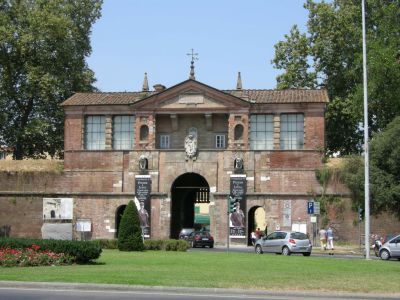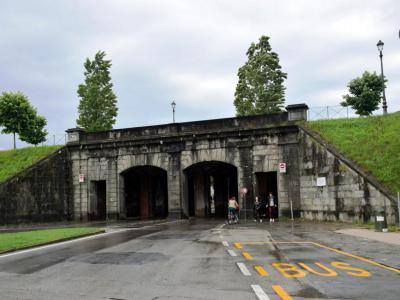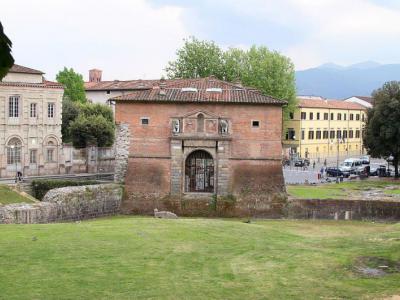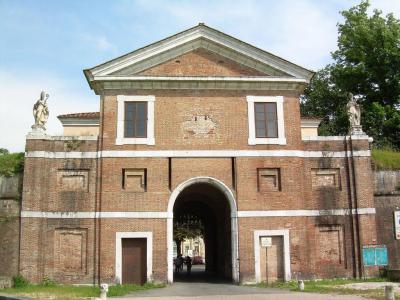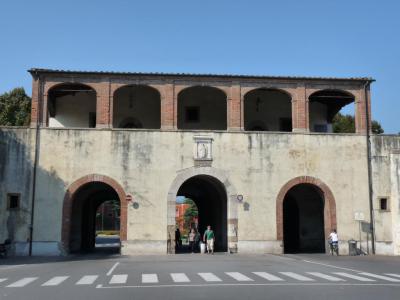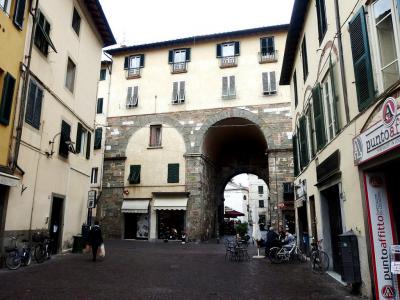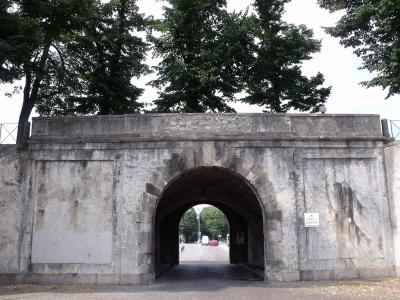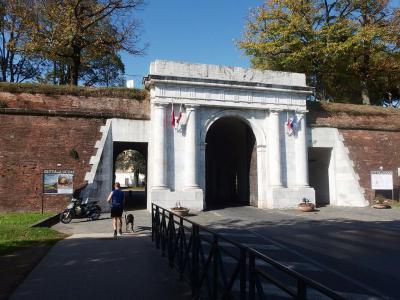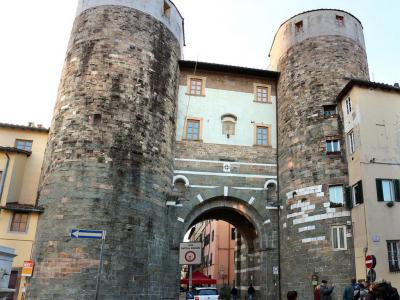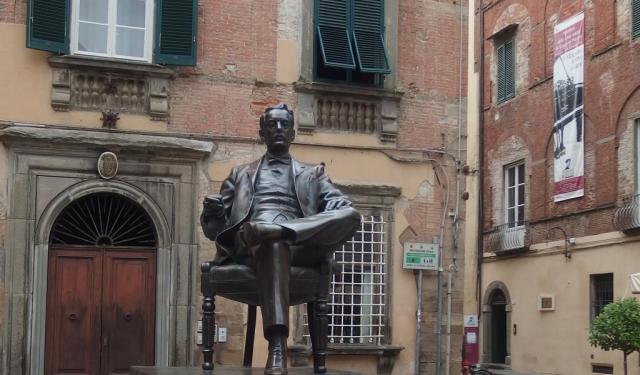
Lucca's City Wall and Gates (Self Guided), Lucca
As one of Italy's Città d'arte's (arts towns), Lucca is famous, among other things, for its well-preserved ancient walls encircling the historic center. From about 570 AD until 1847 the city had been the center of the Longobard administration and the capital of old Tuscany, and as such required a defense system to render it an impenetrable fortress.
Back in the Middle Ages, the walls stood about 11-12 meters high, complete with a number of semicircular and square towers and four monumental gates, which were also flanked by cylindrical towers – in keeping with Roman tradition. Remarkably, of those four gates two are still in place, namely: Porta dei Borghi and Porta San Gervasio, built in the 13th century and miraculously escaped demolition.
Further modified during the Renaissance era as a defensive rampart, today the Walls of Lucca are deprived of their military importance and serve as a pedestrian promenade (Passeggiata delle Mura Urbane), an elevated passage linking the bastions and gates (Porte). Among the latter are:
Porta San Pietro – a southern gate, one of the city's oldest, built in 1565/66;
Porta Sant'Anna – aka Porta Vittorio Emanuele II, constructed in 1910 and initially criticized by locals for its plain design;
Porta Santa Maria – northern gate, established between 1592 and 1594, whose main feature is the statue of Madonna placed in the niche;
Porta San Jacopo – the very latest and simplest of the gates, built in 1930; nicknamed the “hole”, while originally called The Gate of Victory of the 4th of November;
Porta Elisa – named for Elisa Bonaparte Baciocchi, Napoleon's sister and ruler of Lucca.
For a chance to explore closer the imposing walls and gates of Lucca, take this self-guided walking tour.
Back in the Middle Ages, the walls stood about 11-12 meters high, complete with a number of semicircular and square towers and four monumental gates, which were also flanked by cylindrical towers – in keeping with Roman tradition. Remarkably, of those four gates two are still in place, namely: Porta dei Borghi and Porta San Gervasio, built in the 13th century and miraculously escaped demolition.
Further modified during the Renaissance era as a defensive rampart, today the Walls of Lucca are deprived of their military importance and serve as a pedestrian promenade (Passeggiata delle Mura Urbane), an elevated passage linking the bastions and gates (Porte). Among the latter are:
Porta San Pietro – a southern gate, one of the city's oldest, built in 1565/66;
Porta Sant'Anna – aka Porta Vittorio Emanuele II, constructed in 1910 and initially criticized by locals for its plain design;
Porta Santa Maria – northern gate, established between 1592 and 1594, whose main feature is the statue of Madonna placed in the niche;
Porta San Jacopo – the very latest and simplest of the gates, built in 1930; nicknamed the “hole”, while originally called The Gate of Victory of the 4th of November;
Porta Elisa – named for Elisa Bonaparte Baciocchi, Napoleon's sister and ruler of Lucca.
For a chance to explore closer the imposing walls and gates of Lucca, take this self-guided walking tour.
How it works: Download the app "GPSmyCity: Walks in 1K+ Cities" from Apple App Store or Google Play Store to your mobile phone or tablet. The app turns your mobile device into a personal tour guide and its built-in GPS navigation functions guide you from one tour stop to next. The app works offline, so no data plan is needed when traveling abroad.
Lucca's City Wall and Gates Map
Guide Name: Lucca's City Wall and Gates
Guide Location: Italy » Lucca (See other walking tours in Lucca)
Guide Type: Self-guided Walking Tour (Sightseeing)
# of Attractions: 9
Tour Duration: 2 Hour(s)
Travel Distance: 3.7 Km or 2.3 Miles
Author: Dee
Sight(s) Featured in This Guide:
Guide Location: Italy » Lucca (See other walking tours in Lucca)
Guide Type: Self-guided Walking Tour (Sightseeing)
# of Attractions: 9
Tour Duration: 2 Hour(s)
Travel Distance: 3.7 Km or 2.3 Miles
Author: Dee
Sight(s) Featured in This Guide:
- Porta San Pietro (St. Peter's Gate)
- Porta Sant'Anna (St. Anna's Gate)
- Antica Porta San Donato (Old San Donato's Gate)
- Porta San Donato (St. Donato's Gate)
- Porta Santa Maria (St. Maria's Gate)
- Porta dei Borghi (Village Gate)
- Porta San Jacopo (St. Jacopo's Gate)
- Porta Elisa (Elisa's Gate)
- Porta San Gervasio (St. Gervasio's Gate)
1) Porta San Pietro (St. Peter's Gate)
Porta San Pietro is one of the oldest gateways in the historical Walls of Lucca. Designed by the military engineer Alessandro Resta, it forms part of the Renaissance walls and was built in 1565/66 to provide entrance to the southern part of the city. Presently, it is the nearest gate to the train station.
Back in the day, all non-residents entering the town were obliged to register and surrender their weapons, except swords. Those transiting the city could retain their guns but were escorted by armed soldiers.
Porta San Pietro consists of three entrances surmounted in the center by a shield with the coat of arms of St. Peter and the inscription "Libertas", which is the motto of Lucca. On the sides, guarding the entrance, there are two magnificent stone lion figures, placed inside the niches which once served as openings for chains for lifting the drawbridge.
During the 19th century, the gate underwent massive alterations, including the addition of two pedestrian side arches. The central passage has been reserved for transport traffic.
To date the Porta San Pietro has retained its original wooden studded doors and portcullis. Another notable feature is the elegant classical tympanum. As for the space on the ground level, it is currently used as offices and a warehouse for one of local historical reenactment associations.
Back in the day, all non-residents entering the town were obliged to register and surrender their weapons, except swords. Those transiting the city could retain their guns but were escorted by armed soldiers.
Porta San Pietro consists of three entrances surmounted in the center by a shield with the coat of arms of St. Peter and the inscription "Libertas", which is the motto of Lucca. On the sides, guarding the entrance, there are two magnificent stone lion figures, placed inside the niches which once served as openings for chains for lifting the drawbridge.
During the 19th century, the gate underwent massive alterations, including the addition of two pedestrian side arches. The central passage has been reserved for transport traffic.
To date the Porta San Pietro has retained its original wooden studded doors and portcullis. Another notable feature is the elegant classical tympanum. As for the space on the ground level, it is currently used as offices and a warehouse for one of local historical reenactment associations.
Sight description based on Wikipedia.
2) Porta Sant'Anna (St. Anna's Gate)
Porta Sant'Anna, officially known as Porta Vittorio Emanuele, is one of the gates in the Walls of Lucca – colloquially referred to by locals as the "hole" of Saint Anna, after the nearby church of the same name.
The gate was opened in 1910 to serve increased motorized traffic in the western part of the city in view that the nearby Baluardo (bulwark) San Donato, erected in the 17th century for defensive purposes, had no longer been adequate to the task. It was therefore decided that the new entrance would have two arches, in line with the enlarged via Vittorio Emanuele, which was to replace Via di San Paolino as the main westward artery.
In order not to spoil the view of San Donato, a favor was wisely given to two rather simple carriageways (instead of some superstructure) flanked by two pedestrian passages below the bull that separates the shoe from the parapet of the wall, leaving its continuity intact. At the center of the gate, between the two central passageways, the city's marble coat of arms can be seen. The arches dividing the compartment, created in the thickness of the walls, are in exposed brick.
The gate was opened in 1910 to serve increased motorized traffic in the western part of the city in view that the nearby Baluardo (bulwark) San Donato, erected in the 17th century for defensive purposes, had no longer been adequate to the task. It was therefore decided that the new entrance would have two arches, in line with the enlarged via Vittorio Emanuele, which was to replace Via di San Paolino as the main westward artery.
In order not to spoil the view of San Donato, a favor was wisely given to two rather simple carriageways (instead of some superstructure) flanked by two pedestrian passages below the bull that separates the shoe from the parapet of the wall, leaving its continuity intact. At the center of the gate, between the two central passageways, the city's marble coat of arms can be seen. The arches dividing the compartment, created in the thickness of the walls, are in exposed brick.
Sight description based on Wikipedia.
3) Antica Porta San Donato (Old San Donato's Gate)
The Antica Porta San Donato is a westward gateway in the ancient Walls of Lucca. Located on the left side of today's Piazzale Verdi, the gate was built in 1590 to a design by Matteo Civitali. The architect added to the construction a massive bulwark, since the medieval wall in this part of the city was considered weak.
On the upper sides of the façade there are two marble statues of lions. The outer moat, that is still partially visible, was once fitted with a drawbridge. The fortification had a relatively short service life – only about 50 years, when the city's defensive system was expanded and the new Porta San Donato was built, between 1629 and 1639, leaving the old gate enclosed within the walls.
The old San Donato gate was the site of the very last execution in Italy – beheading by the guillotine – that took place on 29 July 1845. Today, the gate is one of Lucca's most popular attractions and houses the municipal tourist office.
On the upper sides of the façade there are two marble statues of lions. The outer moat, that is still partially visible, was once fitted with a drawbridge. The fortification had a relatively short service life – only about 50 years, when the city's defensive system was expanded and the new Porta San Donato was built, between 1629 and 1639, leaving the old gate enclosed within the walls.
The old San Donato gate was the site of the very last execution in Italy – beheading by the guillotine – that took place on 29 July 1845. Today, the gate is one of Lucca's most popular attractions and houses the municipal tourist office.
Sight description based on Wikipedia.
4) Porta San Donato (St. Donato's Gate)
Similarly to its predecessor – the Antica (old) Porta San Donato – dating back to 1590, the new Porta San Donato is a gate in the Walls of Lucca that faces west. It was built between 1629 and 1639 as part of the Renaissance walls circle to replace the old San Donato gate that is now enclosed within the Walls, at Piazzale Verdi. Originally the gate was equipped with a drawbridge.
Porta San Donato is one of Lucca's best preserved gateways. The architect Muzio Oddi adorned the structure with marble framing on the windows and triangular gable. The latter is also framed on the sides with two marble statues representing San Donato and San Paolino. Inside there is a fireplace and a pit. The gate's central entrance is flanked by what seems to be two smaller arches, one of which is false.
Porta San Donato is one of Lucca's best preserved gateways. The architect Muzio Oddi adorned the structure with marble framing on the windows and triangular gable. The latter is also framed on the sides with two marble statues representing San Donato and San Paolino. Inside there is a fireplace and a pit. The gate's central entrance is flanked by what seems to be two smaller arches, one of which is false.
Sight description based on Wikipedia.
5) Porta Santa Maria (St. Maria's Gate)
Porta Santa Maria is a northern gateway in the Walls of Lucca. It was built between 1549 and 1592 as part of the Renaissance walls, and was designed by architect Ginese Bresciani and built by Michelangelo Gabrielli. The gate is dedicated to Virgin Mary – the marble statue of Madonna is found in a niche outside the entrance.
Originally, Porta Santa Maria had a single entrance; the two side openings were added later.
On both sides of the gateway there are several statues, each representing a panther – the symbol of Lucca. Under the central arch there are two frescoes depicting the Annunciation, featuring Archangel Gabriel on the one side and Madonna on the other. At the center of the internal façade is the marble bas-relief depicting St. Peter along with the inscription "Libertas" underneath, the ancient motto of the city.
From 1883 to 1932 there had been a tram line operating with the terminus of Lucca-Ponte a Moriano outside the city. In 1884 the line was extended with a new terminal station at Porta San Pietro, effectively passing through the Santa Maria gate. Today, the central passage of the gate is solely pedestrian, with the side openings reserved for transit of vehicles.
Originally, Porta Santa Maria had a single entrance; the two side openings were added later.
On both sides of the gateway there are several statues, each representing a panther – the symbol of Lucca. Under the central arch there are two frescoes depicting the Annunciation, featuring Archangel Gabriel on the one side and Madonna on the other. At the center of the internal façade is the marble bas-relief depicting St. Peter along with the inscription "Libertas" underneath, the ancient motto of the city.
From 1883 to 1932 there had been a tram line operating with the terminus of Lucca-Ponte a Moriano outside the city. In 1884 the line was extended with a new terminal station at Porta San Pietro, effectively passing through the Santa Maria gate. Today, the central passage of the gate is solely pedestrian, with the side openings reserved for transit of vehicles.
Sight description based on Wikipedia.
6) Porta dei Borghi (Village Gate)
Porta dei Borghi is the oldest gateway in the medieval Walls of Lucca. It faces north and was built between 1198 and 1265; the gate was almost completely demolished during the construction of the Renaissance walls. The only other gate of the original four, remaining from the 13th-century circle, is Porta San Gervasio located at the top of Via Santa Croce.
Today Porta dei Borghi marks the end of Via Fillungo, and is incorporated in the more recent, 16th-17th-century fortification, not far from Porta Santa Maria, which in the second half of the 16th century assumed the role of main entrance to the city from the north. The gate has a single central opening (once there were two, but one is now walled up) with two towers on either side.
The two towers, in gray sandstone with white limestone decorations, originally had battlements and a walkway that linked them at the top. Both towers and the upper part of the gate are currently used as private homes.
The gate has a wide entrance, eight meters high, covered by a round arch. Inside there is an ancient fresco, framed by a lunette, depicting Madonna with the Child, restored in 2008 by the Municipality of Lucca.
Today Porta dei Borghi marks the end of Via Fillungo, and is incorporated in the more recent, 16th-17th-century fortification, not far from Porta Santa Maria, which in the second half of the 16th century assumed the role of main entrance to the city from the north. The gate has a single central opening (once there were two, but one is now walled up) with two towers on either side.
The two towers, in gray sandstone with white limestone decorations, originally had battlements and a walkway that linked them at the top. Both towers and the upper part of the gate are currently used as private homes.
The gate has a wide entrance, eight meters high, covered by a round arch. Inside there is an ancient fresco, framed by a lunette, depicting Madonna with the Child, restored in 2008 by the Municipality of Lucca.
Sight description based on Wikipedia.
7) Porta San Jacopo (St. Jacopo's Gate)
Porta San Jacopo is a yet another northern gateway in the Walls of Lucca, and the most latest one – built in 1930. For its architectural simplicity, the locals have jokingly referred to this gate as the “hole”, although originally its official title was quite grand – Porta IV Novembre (the Gate of Victory of the 4th of November).
Porta San Jacopo has a single entrance which is now mostly used by the intensified motor traffic.
Porta San Jacopo is also one of the key tourist attractions in Lucca. Inside the gate there is an inscription, dating back to the Fascist era, which is partially erased but still legible.
Porta San Jacopo has a single entrance which is now mostly used by the intensified motor traffic.
Porta San Jacopo is also one of the key tourist attractions in Lucca. Inside the gate there is an inscription, dating back to the Fascist era, which is partially erased but still legible.
Sight description based on Wikipedia.
8) Porta Elisa (Elisa's Gate)
Porta Elisa is an eastward gate in the Walls of Lucca. The original plan for the Walls did not envisage any gate on the eastern side of the city – for fear of attack from Florence. However, during the Napoleonic domination, when the threat of invasion from the Florentine dominion was none, it became necessary to obtain direct access to the road which led to the important cities of the Lucca state, such as Capannori and Villa Basilica, and further afield towards Pescia, Montecatini Terme, Pistoia and Florence.
The gate was constructed between 1809 and 1811 and, unlike its predecessors, was not dedicated to a saint (according to the strict secularism of the time), but instead was named after Elisa Baciocchi Bonaparte, Napoleon's sister, who against the will of her brother had married the fallen nobleman Felice Baciocchi, eventually the Prince of Lucca and Piombino.
The gate consists of three arches with a modest ornamentation in Neoclassical style with Doric entablature supported by two pairs of Tuscan columns. A low parapet is the only part of the building that slightly surmounts the level of the Walls. The gate's white marble masonry starkly contrasts the red bricks of the Walls.
From the inside the gate was to appear as a triumphal arch, marking the outset of a new road to the city center, called Via Elisa, which was originally intended to gut the ancient quarters of the city by demolishing the Romanesque Porta San Gervasio and creating a large arcaded street towards Piazza San Michele. However, following the fall of the Napoleonic Empire, the demolition plans were aborted, with only one stretch of Via Elisa completed with the ensued destruction of medieval convents of the Carmine and the Capuchins.
The gate was constructed between 1809 and 1811 and, unlike its predecessors, was not dedicated to a saint (according to the strict secularism of the time), but instead was named after Elisa Baciocchi Bonaparte, Napoleon's sister, who against the will of her brother had married the fallen nobleman Felice Baciocchi, eventually the Prince of Lucca and Piombino.
The gate consists of three arches with a modest ornamentation in Neoclassical style with Doric entablature supported by two pairs of Tuscan columns. A low parapet is the only part of the building that slightly surmounts the level of the Walls. The gate's white marble masonry starkly contrasts the red bricks of the Walls.
From the inside the gate was to appear as a triumphal arch, marking the outset of a new road to the city center, called Via Elisa, which was originally intended to gut the ancient quarters of the city by demolishing the Romanesque Porta San Gervasio and creating a large arcaded street towards Piazza San Michele. However, following the fall of the Napoleonic Empire, the demolition plans were aborted, with only one stretch of Via Elisa completed with the ensued destruction of medieval convents of the Carmine and the Capuchins.
Sight description based on Wikipedia.
9) Porta San Gervasio (St. Gervasio's Gate)
Porta San Gervasio is one of the four gates from the 13th century that once formed part of the Walls of Lucca. It was almost completely demolished during the construction of the Renaissance walls (the latter still visible today); the only other similar gate still in place is Porta dei Borghi, located on Via Fillungo.
Also known as dell'Annunziata (the Annunciation gate), Porta San Gervasio was completed in 1255 and was dedicated to Saints Gervasio and Protasio.
The gate has a wide opening, eight meters high, covered by a round arch; the inner lunette carries the image of Madonna and the Child, with two kneeling Saints (probably Gervasio and Protasio) and two Angels uncovering the curtain, as well as a fragment of San Giovannino at the foot of the Virgin.
The two towers, made of gray sandstone with white limestone decorations, originally had battlements and a walkway connecting them at the top. Back in the day, the gate had a drawbridge over a moat; the latter is still preserved and runs opposite Via del Fosso.
Today the two towers are used as private residences. In the top left one, seen from Via del Fosso, Italo Meschi (1887-1957), the guitarist, poet and anarchist-pacifist once lived; while in the right-hand tower, his cousin, painter Alfredo Meschi (1905-1981), had a studio.
The gate underwent restoration in 2006-2007.
Also known as dell'Annunziata (the Annunciation gate), Porta San Gervasio was completed in 1255 and was dedicated to Saints Gervasio and Protasio.
The gate has a wide opening, eight meters high, covered by a round arch; the inner lunette carries the image of Madonna and the Child, with two kneeling Saints (probably Gervasio and Protasio) and two Angels uncovering the curtain, as well as a fragment of San Giovannino at the foot of the Virgin.
The two towers, made of gray sandstone with white limestone decorations, originally had battlements and a walkway connecting them at the top. Back in the day, the gate had a drawbridge over a moat; the latter is still preserved and runs opposite Via del Fosso.
Today the two towers are used as private residences. In the top left one, seen from Via del Fosso, Italo Meschi (1887-1957), the guitarist, poet and anarchist-pacifist once lived; while in the right-hand tower, his cousin, painter Alfredo Meschi (1905-1981), had a studio.
The gate underwent restoration in 2006-2007.
Walking Tours in Lucca, Italy
Create Your Own Walk in Lucca
Creating your own self-guided walk in Lucca is easy and fun. Choose the city attractions that you want to see and a walk route map will be created just for you. You can even set your hotel as the start point of the walk.
Lucca Introduction Walking Tour
Lucca is called many things: a city of arts, a city of churches, gardens, towers. Most of all it is known for its walls. From Roman times until now the walls have stood. It is the only city in Italy that has kept its walls intact.
The inner walled city is laid out in the ancient Roman grid plan. The Piazza San Michele is the site of the old forum. Bits of the Roman amphitheater can be found in... view more
Tour Duration: 2 Hour(s)
Travel Distance: 3.2 Km or 2 Miles
The inner walled city is laid out in the ancient Roman grid plan. The Piazza San Michele is the site of the old forum. Bits of the Roman amphitheater can be found in... view more
Tour Duration: 2 Hour(s)
Travel Distance: 3.2 Km or 2 Miles
Puccini's Lucca
One of the greatest musical talents of mankind, Italian composer Giacomo Puccini, was born and spent a substantial part of his life in the Tuscan city of Lucca. Today the legacy of Puccini resonates all over the world and even more so here.
Puccini's ancestors, also musicians, moved to Lucca in 1719. The future maestro was born in a house that had belonged to his family since 1815 – Casa... view more
Tour Duration: 1 Hour(s)
Travel Distance: 1.5 Km or 0.9 Miles
Puccini's ancestors, also musicians, moved to Lucca in 1719. The future maestro was born in a house that had belonged to his family since 1815 – Casa... view more
Tour Duration: 1 Hour(s)
Travel Distance: 1.5 Km or 0.9 Miles
The Most Popular Cities
/ view all
